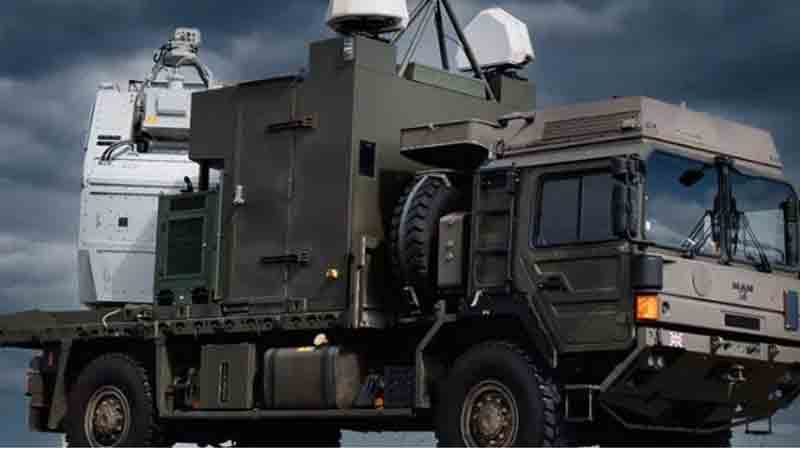The United Kingdom has made a notable advancement in combating the escalating threat of drone warfare with the successful trials of a high-power microwave weapon called RapidDestroyer. This system, developed by a consortium led by the French defense company Thales, utilizes radio frequencies to incapacitate the electronics of unmanned aerial vehicles, effectively neutralizing entire drone swarms.
Conducted by the UK Ministry of Defence in West Wales, the trials showcased the weapon’s capability to track and neutralize over 100 drones, including two swarms of eight, marking a significant achievement in the global competition to create directed energy weapons.
This innovation emerges as military forces around the world confront the rise of inexpensive, mass-produced drones that have transformed contemporary battlefields, particularly evident in the ongoing conflict in Ukraine. The success of RapidDestroyer indicates a move towards cost-effective, wide-area countermeasures, while also prompting discussions about the technology’s limitations and its broader impact on warfare.
RapidDestroyer signifies a significant advancement in the UK’s strategy to tackle the challenges posed by unmanned aerial systems. Unlike conventional air defense systems that depend on missiles or kinetic weapons, this microwave-based technology emits high-frequency radio waves to disrupt or destroy the electronic systems of drones, leading to their malfunction or crash.
Mounted on a flatbed truck, this system is engineered for mobility, although its significant power demands require a strong energy source. During testing at a range in West Wales, the Royal Artillery Trials and Development Unit, along with the 7th Air Defence Group, evaluated the weapon against various unmanned aerial systems, successfully hitting targets at distances of up to one kilometer.
The UK Ministry of Defence emphasized the system’s economical engagement cost, estimated at only 10 pence per shot, presenting it as an attractive alternative to missile-based defenses, which can incur costs in the thousands of dollars per use.
The technology behind RapidDestroyer is based on directed energy weapon principles, utilizing concentrated electromagnetic energy to deliver precise effects without the need for physical projectiles.
High-power microwave systems like RapidDestroyer produce powerful bursts of radio frequency energy that can incapacitate the circuits of targeted devices. This “hard-kill” method causes physical damage to the drone’s electronics, setting it apart from traditional electronic warfare techniques that typically rely on jamming to interfere with communications or navigation.
The system’s capability to engage multiple targets at once makes it particularly effective against drone swarms, where numerous small, agile unmanned systems can overwhelm standard defenses.
The consortium led by Thales, which includes partners such as QinetiQ, Teledyne e2v, and Horiba Mira, has developed RapidDestroyer to be predominantly automated, enabling a single operator to manage the system from a military vehicle like the MAN Support Vehicle 6T.
The importance of this advancement is paramount in the realm of contemporary warfare, where drones have emerged as a crucial element in conflicts. In Ukraine, both Russian and Ukrainian military forces have made extensive use of unmanned systems, with drones contributing significantly to combat-related casualties.
Roman Kostenko, the chairman of Ukraine’s parliamentary defense and intelligence committee, has estimated that unmanned systems account for as much as 80% of casualties in the ongoing conflict, highlighting the pressing need for effective countermeasures. The cost-effectiveness and scalability of small drones have made traditional defense systems, like surface-to-air missiles, increasingly unfeasible.
A single missile can exceed $100,000 in cost, whereas a basic commercial drone can be acquired for just a few hundred dollars, creating a financial imbalance that benefits the aggressor. RapidDestroyer’s cost-efficient engagement strategies present a viable solution, enabling defenders to address threats without exhausting their resources.
Although the capabilities of the RapidDestroyer are noteworthy, its design strikes a careful balance between advantages and limitations. The system’s dependence on microwave energy means its performance can be affected by environmental conditions such as weather and terrain.
In densely populated urban areas, the presence of numerous reflective surfaces and electronic devices may hinder the weapon’s accuracy or operational range. Additionally, while the truck-mounted design offers mobility, it also introduces logistical challenges, as the system requires substantial power to function effectively.
During the trials in West Wales, the weapon showcased its capability to target objects at approximately one kilometer. However, extending this functionality to greater distances or more intricate situations poses a significant challenge.
Experts have raised concerns that microwave weapons may not be ideal for use in civilian environments, as they risk causing unintended harm to non-military electronic devices, including medical apparatus and communication systems.
The development of the RapidDestroyer is part of a larger international initiative to utilize directed energy weapons for air defense. The United States has taken a leading role in this area, exemplified by the Tactical High-power Operational Responder (THOR), which has been developed by the US Air Force.
THOR, comparable in size to a shipping container, employs a microwave-based method to neutralize drone swarms. In April 2023, the Air Force successfully conducted tests with THOR against unmanned aerial vehicles, proving its effectiveness in engaging multiple targets at tactically significant distances. The US Navy is also progressing with its own microwave weapon, named Leonidas, which has been developed by Epirus for use on ships.
In contrast to the truck-mounted RapidDestroyer, Leonidas is engineered to be compatible with naval platforms, offering a streamlined solution for countering drones at sea. The Navy intends to evaluate a related system, Project METEOR, in 2026, which aims to intercept both ballistic missiles and drones.
Other countries are also making substantial investments in directed energy technologies. China has achieved notable advancements with its Hurricane-3000, a high-power microwave system created by NORINCO. Introduced at the Zhuhai Airshow in November 2024, the Hurricane-3000 can target objects at distances of up to three kilometers, providing a hemispherical defense against drone swarms.
Field tests have shown that it can effectively neutralize a variety of unmanned systems, ranging from small reconnaissance drones to larger strike aircraft. In contrast, Russia has concentrated on electronic warfare technologies that integrate jamming with some directed energy capabilities; however, its microwave weapons are not as sophisticated as those developed by Western or Chinese nations.
These international advancements underscore the competitive landscape in the development of drone countermeasures, as each country strives to tackle the same strategic issue: how to protect against a cost-effective, scalable threat that can be deployed en masse.
The historical background of directed energy weapons sheds light on the importance of RapidDestroyer. The pursuit of microwave-based systems dates back to the Cold War, during which both the United States and the Soviet Union investigated electromagnetic weapons to counteract missile and aircraft threats.
In 2006, the UK and US conducted joint tests of a radio frequency demonstrator created by MBDA, which was considered for potential use on cruise missiles or unmanned aerial vehicles. These initial experiments established a foundation for contemporary systems like RapidDestroyer, which leverage advancements in power generation, antenna technology, and automation.
The UK’s investment in directed energy weapons has significantly increased in recent years, largely due to the rising use of drones in conflicts such as those in Syria, Yemen, and Ukraine. In 2019, the Ministry of Defence committed £130 million to the development of laser and radio-frequency demonstrators, with field trials scheduled for 2023.
The development of the RapidDestroyer aligns with the UK’s overall defense strategy. Given the limitations of military budgets in comparison to the United States and China, the UK aims to enhance the effectiveness of its investments by concentrating on innovative and cost-efficient technologies.
The consortium led by Thales has maintained over 135 skilled jobs within the UK, bolstering the domestic defense sector while supporting national security goals. The integration of this system into the British Army’s air defense framework is anticipated by 2027, although the current demonstrator will not be deployed directly. Instead, insights and data from the West Wales trials will guide future developments, potentially resulting in a more compact or adaptable platform.
From a tactical standpoint, RapidDestroyer presents considerable benefits for layered air defense. It offers a low-cost, quick-response solution that complements more expensive systems like the Patriot or Sky Sabre, which are designed to address high-value threats such as manned aircraft or ballistic missiles.
In a situation where an opponent launches numerous drones to overwhelm defenses, RapidDestroyer has the capability to neutralize the swarm, thereby conserving missile resources for more critical threats. Nevertheless, its dependence on line-of-sight targeting and susceptibility to electronic countermeasures, like electromagnetic shielding found on advanced drones, may restrict its effectiveness in specific situations.
While the system’s automation alleviates the workload for operators, it also raises concerns regarding decision-making in complex environments where friendly and enemy drones might be in close proximity.
The geopolitical ramifications of RapidDestroyer extend beyond military engagements. As NATO allies confront increasing threats from both state and non-state actors utilizing drones, the UK’s investment in microwave weaponry enhances the alliance’s overall defense capabilities.
The system’s ability to deter adversaries that depend on low-cost unmanned systems could alter the cost-benefit analysis of asymmetric warfare. However, the spread of directed energy technologies also presents potential dangers.
If unscrupulous governments or non-state actors acquire similar technologies, they could exploit them to disrupt civilian infrastructure or stifle dissent, given the technology’s capacity to indiscriminately target electronics in urban environments.
Looking forward, the success of RapidDestroyer is likely to inspire further advancements in both offensive and defensive technologies. Drone manufacturers may respond by creating systems with improved electromagnetic shielding or autonomous navigation that does not depend on vulnerable electronic components.
Such innovations could diminish the effectiveness of current microwave weapons, leading to a new cycle of countermeasures and counter-countermeasures. Additionally, the ethical implications of deploying directed energy weapons in populated areas will require thorough examination.
The UK Ministry of Defence has highlighted the accuracy of RapidDestroyer; however, concerns persist regarding the potential collateral damage to civilian electronics, especially in scenarios where military and civilian areas overlap.
The introduction of RapidDestroyer signifies a crucial advancement in air defense, showcasing the need to respond to an evolving threat environment. Its capability to effectively counter drone swarms at a low cost addresses a significant weakness revealed by contemporary conflicts, hinting at a future of warfare dominated by directed energy systems.
Nevertheless, the technology’s limitations and the global competition to create similar systems highlight the challenges of sustaining a strategic advantage. As armed forces invest in these technologies, they must find a balance between operational efficiency and the risk of unintended repercussions.
Will RapidDestroyer and similar innovations truly transform the battlefield, or will they simply alter the dynamics of an ongoing technological arms race? The outcome may hinge on how swiftly adversaries adapt and whether the international community can establish regulations to manage the deployment of such formidable technologies.
Discover more from Defence Talks | Defense News Hub, Military Updates, Security Insights
Subscribe to get the latest posts sent to your email.





